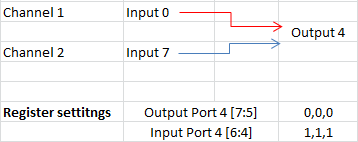Hey,
I am trying to switch video inputs using the SN65LVPC408 crosspoint switch and am not able to get a good signal output from the chip.
1. I've connected the SN65LVCP408 chip to one/two cameras and the output to a BCM2835 chip in order to switch between the cameras.
2. When we switch the right inputs to the right outputs, we notice data streaming to the right outputs however the data is very noisy and the total amplitude is ~200mV riding a 2V common mode whereas the input's voltage range is LVDS ~1.5V amplitude.
3. When we switch different inputs to the relevant outputs, we notice a constant 2V common mode.
4. The description of sections 2-3 is also the case when there is no load at the output of the SN65LVCP408.
5. It seems the SN65LVCP408 is receiving a steady 3.3V.
6. We have followed the requirements for resetting the chip (RESN) and keep SWT=0, I2C_EN=1.
7. We've tried playing a little bit with the I2C registers. We've managed to divert the two input cameras to the output ports and we notice the streaming information change between no data to a low ~200mV noisy data.
8. We've tried playing with the Pre-Emphasis and the Equalization registers. It changes the output but not to the better...
a. Is there any further application notes or an application's schematics example and code?
b. Has anyone encountered this phenomenon and knows how to fix it or what we've done wrong? (non LVDS noisy output voltage at ~200mV pk to pk riding a ~2V common mode)]
Thanks,
Yoav





